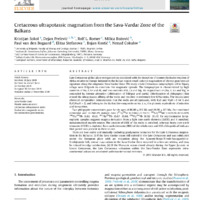Cretaceous ultrapotassic magmatism from the Sava-Vardar Zone of the Balkans
Објеката
- Тип
- Рад у часопису
- Верзија рада
- објављена верзија
- Језик
- енглески
- Креатор
- Kristijan Sokol, Dejan Prelević, Rolf Romer, Milica Božović, Paul van den Bogaard, Elitsa Stefanova, Bojan Kostić, Nenad Čokulov
- Извор
- Lithos
- Датум издавања
- 2020
- Сажетак
-
Late Cretaceous global plate reorganization associated with the inception of counterclockwise rotation of Africa relative to Europe initiated in the Balkan region small-volume magmatism of diverse geochemical signature along the enigmatic Sava-Vardar Zone. We study a Late Cretaceous lamprophyric sill in Ripanj village near Belgrade to constrain this magmatic episode. The lamprophyre is characterized by high
contents of Na, P, Fe and Al, and low contents of K, Ca and Mg. Its original nature (Na, K, Ca and Mg) is concealed by intense alteration (albitization of feldspar and partial chloritization of phlogopite) that erased the ultrapotassic affinity of the rocks and resulted in extremely low K/Na ratios. The recalculated chemical composition demonstrates that the rocks are ultrapotassic, with K2O and MgO >3 wt % and
K2O/Na2O > 2, and belong to the durbachite-vaugnerite series, i. e., the plutonic equivalents of minettes and kersantites.
Two phlogopite concentrates gave AreAr ages of 86.80 ± 0.5 Ma and 86.90 ± 0.5 Ma. Our combined elemental and SreNdePb isotope data (87Sr/86Sr 0.70667e0.70677, 143Nd/144Nd 0.512426e0.512429, 206Pb/204Pb 18.82e19.13, 207Pb/204Pb 15.67e15.68, 208Pb/204Pb 38.92e39.19) for representative lamprophyric
samples suggests magma derivation from a light rare earth elements (LREE) and K enriched, metasomatized mantle source. The content of LREE of the rocks is enriched, whereas heavy rare earth elements (HREE) is depleted. Rare earth elements (REE) of the whole rock and REE of diopside all indicate that garnet was present in their source.
There are two viable and mutually-excluding geodynamic scenarios for the Late Cretaceous magmatism in the Balkans: (i) If the Sava-Vardar ocean still existed in the Late Cretaceous and was subducted under the European plate with arc volcanism along the Apuseni-Banat-Timok-Panagyurishte-Srednjogorje belt, coeval magmatism in the Sava-Vardar Zone occurred in a fore-arc setting, and may be related to ridge subduction; (ii) If the Mesozoic ocean closed already during the Upper Jurassic or Lower Cretaceous, the Late Cretaceous volcanism within the Sava-Vardar Zone represents intracontinental
volcanism associated with transtensional tectonics. - Број
- 105268
- issn
- 0024-4937
- Subject
- Sava-Vardar zona, metasomatizam omotača, Kredne ultrakalijske stene, Durbachite-vaugnerite serija
- Sava-Vardar zone, Mantle metasomatism, Cretaceous ultrapotassic rocks, Durbachite-vaugnerite series, Reconstruction geochemistry
- Шира категорија рада
- M20
- Ужа категорија рада
- М21а
- Права
- Отворени приступ
- Лиценца
- Creative Commons – Attribution-No Derivative Works 4.0 International
- Формат
- Медија
 Sokol et al. 2020.pdf
Sokol et al. 2020.pdf
Kristijan Sokol, Dejan Prelević, Rolf Romer, Milica Božović, Paul van den Bogaard, Elitsa Stefanova, Bojan Kostić, Nenad Čokulov. "Cretaceous ultrapotassic magmatism from the Sava-Vardar Zone of the Balkans" in Lithos (2020) М21а
This item was submitted on 22. децембар 2021. by [anonymous user] using the form “Рад у часопису” on the site “Радови”: https://dr.rgf.bg.ac.rs/s/repo
Click here to view the collected data.